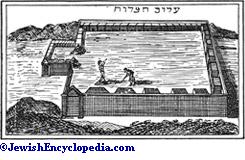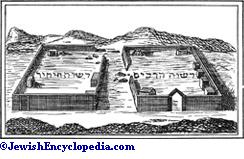'ERUB:
Mixture or amalgamation; ideal combination of things separate. There are several kinds of 'erub.
'Erub (par excellence):The law concerning the transportation of objects from one place to another on the Sabbath distinguishes several sorts of places ("reshuyot"), of which the following three may be mentioned: (1) a place or places belonging to an individual ("reshut ha-yaḥid"), such as houses and enclosed spaces, being the property of one person; (2) open spaces belonging to the public, such as highroads and thoroughfares ("reshut ha-rabbim"); (3) places such as the sides and corners of streets, and fields not enclosed, which can not be considered either as public or as private property, but have some peculiarities of both ("karmelit ").
Private and Public Spaces.According to the traditional interpretation of Ex. xvi. 29, it is forbidden to remove on the Sabbath things from an enclosed space which is private property to an open space which is public property. Likewise it is prohibited to transport objects a distance of more than four cubits within an open space. The only space in which it is allowed to remove things freely is an enclosed space which is the property of an individual. But to modify the inconvenient consequences of the Law the 'erub was introduced, which, so to speak, converted an open space into an enclosed one. If a space is not completely enclosed, the completion of the enclosure is, under certain circumstances, effected by a single rod or wire placed across the open parts, or by a pole placed at one of the sides of the open part. Such completion may be noticed in some ancient towns and villages in which there is a Jewish congregation, at the ends of streets leading out of the place; and it is known by the name of "'erub."
'Erube ḥaẓerot ("combination among the inhabitants of courts"):The courts, being as a rule surrounded by houses or other buildings, thus satisfy one condition of reshut ha-yaḥid, inasmuch as they are an enclosed space; but as they are not the property of one individual, they partake of the nature of public property, and thus the removal of things within them on the Sabbath would be forbidden. In order to satisfy the second condition, namely, of being one person's property, the inhabitants combine and form a union, each member contributing something toward a meal and placing it in a room accessible to all of them. They thus form one family, and the court is reshut ha-yaḥid. The contributions are called "'erube ḥaẓerot." In the same way a street with all its courts may be turned into reshut ha-yaḥid, and the term "'erube ḥaẓerot" is then changed into "shittufe mebo'ot" (combination of the courts and houses in a street).

Two thousand cubits constitute a Sabbath-day's journey; that is to say, a man, taking his dwelling-place as a center, may move on the Sabbath forward and backward as often as he wishes within a circle the radius of which is 2,000 cubits. The greatest length he may move in one line is the length of the diameter, or 4,000 cubits. If, however, a person intends to go on the Sabbath to a place lying beyond the radius, but within 4,000 cubits of his starting-point, he has to transfer his abode for the day of the Sabbath from the original center to a point in the circumference which becomes the new center, and he may walk from this point in any direction one Sabbath-day's journey. This transfer is only permissible for the purpose of performing a "miẓwah" (e.g., circumcision). The transfer must be marked by placing on Friday some food in the new center for Sabbath, and the name "'erube teḥumin" is especially applied to this food. The "teḥum" of the original center is thus combined with that of the new one.

See
- Maimonides, Yad, Shabbat, xiv. et seq.;
- ib. 'Erubin;
- ib. Yom-Ṭob, vi.;
- Shulḥan 'Aruk, Oraḥ, Ḥayyim, 346, 408, 527;
- Geiger, Urschrift, p. 124;
- idem, Jüd. Zeit. ii. 24;
- Paḥad Yiẓḥak, s.v. 'Erub and 'Erube.

